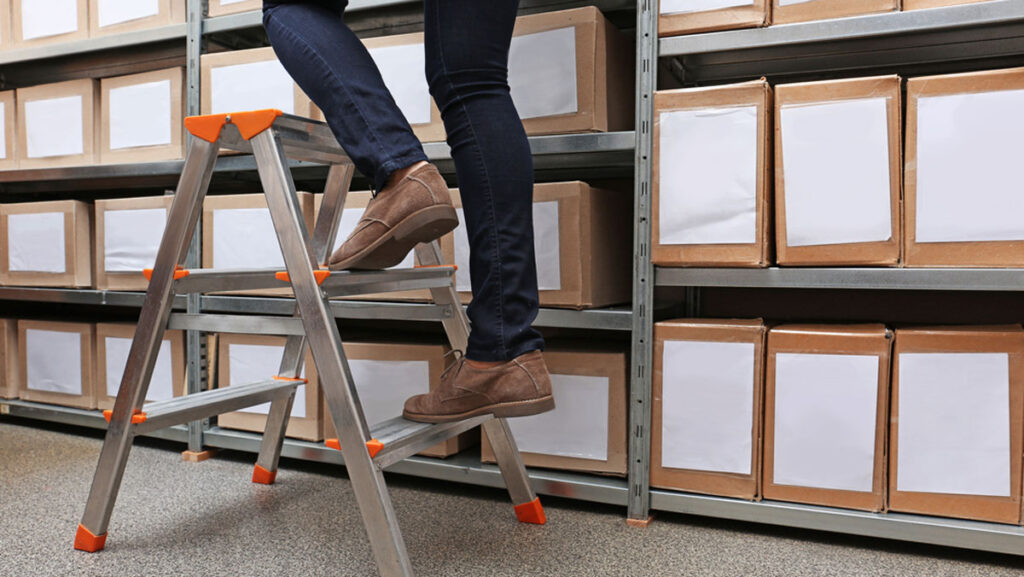Whether working at height is part of daily operations or just the occasional use of a stepladder to retrieve supplies from the stockroom, unless staff are fully aware of the risks involved, falls can occur at any time and serious injuries may result.
Any worker can be at risk of a fall from height, from high up on a platform or vehicle, or down into an inspection pit. Just slipping off the bottom rung of a set of steps can result in multiple breaks in the ankle or, on rare occasions, a short fall can involve more serious head injury and lead to death.
It is essential therefore that a thorough review is made of any working practices, both those that are official company policy and also those where shortcuts have been commonly adopted.

Common Causes of Falls from Height
Whatever the nature of work, falls at height are common. A simple task such as putting up festive decorations can result in staff falling off stepladders, or worse still, off office chairs.
The most common causes of workers falling from height are:
- Overstretching when using ladders.
- Standing on insecure platforms, such as when not positioned correctly on uneven ground.
- Not using equipment correctly, e.g., not tying-in ladders or not always maintaining three points of contact.
- Using inappropriate equipment, or the proper equipment not being available.
Other causes include:
- The area not being correctly guarded, e.g., no barriers around trenches.
- Poor housekeeping, such as obstacles being in the way or slipping on spillages.
- Not following company procedures as set out in your risk assessment, i.e., taking shortcuts.
Avoiding the Dangers
Falls from height remain the biggest cause of workplace fatalities in Great Britain. In 2022-23, 40 people died as a result of a fall from height while carrying out their work. This equates to a staggering 30% of all work injury related deaths during that period.*
While some of these fatalities have been falling from high up, such as through fragile roofs, where safe access had not been provided, serious or even fatal injuries can occur even when the fall is less than 2 metres.
Employers therefore should ensure no work is done at height if it is avoidable, for example:
- Arrange office supplies or client files so everything is within reach, without the aid of stepladders.
- On plant, machinery or road tankers sampling, checking and control operating points can often be located at ground level.
- Cleaning of plant might be carried out from ground level using a foam jet cleaner, or cleaning might be reduced by better extraction of dust, fumes etc.
*HSE work injury statistics for 2022-23
Where Tasks Involve Working at Height
Where working at height is unavoidable, all reasonably practicable measures should be taken to prevent workers from falling. Employers must ensure an appropriate risk assessment is carried out and the risks identified are properly managed. This includes the supply and maintenance of appropriate equipment and ensuring all staff using that equipment have been properly trained.
Improper use of ladders is one of the main causes of falls from height. To use ladders safely, staff should always maintain three points of contact. That means two hands and one foot or two feet and one hand on the ladder at all times. Moving quickly often results in only two-point contact. A conscious effort to maintain three-point contact is therefore essential throughout the task undertaken.
You can find important information from the Ladder Association about purchasing telescopic ladders that meet satisfy British Safety Standards here.
What Happens After a Fall from Height?
Whether a serious or minor injury occurred, all falls from height should be reported and recorded in the accident book, as soon as possible after the incident. Such occurrences will help you spot where there are potential weaknesses in your safety procedures and what appropriate control measures you will need to put in place as a result.
In conclusion, you don’t have to be involved in working from height as your principal business for your workers to be at risk from falls from height. For example, even if you run a small retail concern or have office premises, now may be a good time to review any policies and procedures applicable to any tasks that involve working at height. Do they cover every possible occasion? Are they adequate, or do they need updating? Are staff aware of the dangers and comply with your procedures? Or are they behaving contrary to instructions?
Finding out and ensuring the appropriate safety controls are in place is essential — before someone has a fall. And remember, keeping clear records of your health and safety procedures and employee training will help in the event of a claim should a fall occur.
This article is supported by our risk management partners, Health & Safety Click. For more information, please visit www.archriskmanagement.co.uk. Registration is free for existing Arch policyholders. If you require more information, please contact your local Arch branch manager.